The Best Double Chocolate Cake with Black Velvet Icing
This post may contain affiliate links. Please read my disclosure policy.
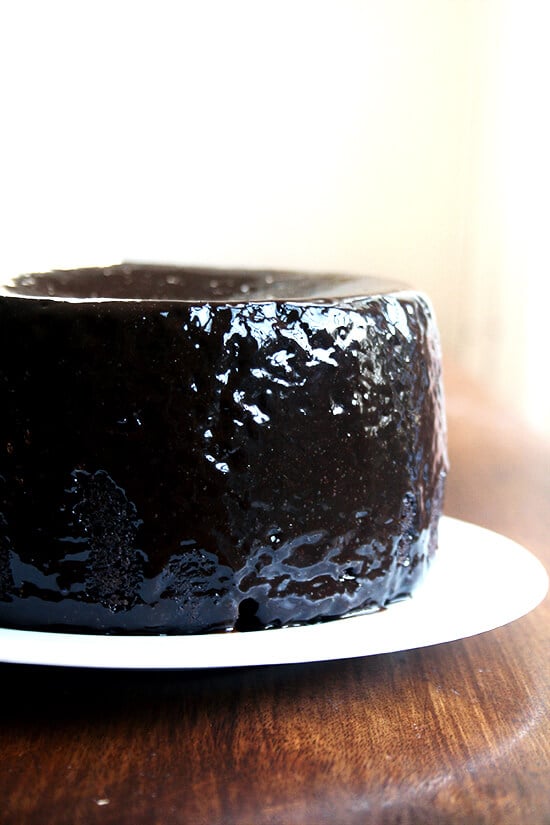
This double chocolate cake is everything a chocolate cake should be: fudgy, moist, intensely chocolaty. When assembled into layers with chocolate ganache slathered in between, as the original recipe instructs, this cake becomes the perfect birthday finale for any chocolate lover; when topped with black velvet icing, as pictured here, this cake becomes an elegant dessert, a perfect treat to enjoy with morning coffee or afternoon espresso.
Why Is This Cake So Good?
A few things:
- Unsweetened cocoa powder, which imparts a deep, intense chocolate flavor and a rich, fudgy texture.
- Buttermilk, the magic ingredient in many a cake, namely this buttermilk blueberry breakfast cake.
- Oil (as opposed to butter), which keeps cakes incredibly moist (read: The Case For Making Cakes with Oil as Opposed to Butter).
The difference between Dutch-process and natural cocoa powder:
This info comes from Regan Daley’s In the Sweet Kitchen:
- Natural cocoa powder is produced if virtually all of the cocoa butter is removed from the cocoa liquor, leaving a dry cake that is then ground to a fine powder. Natural cocoa powder is quite acidic, so can be used as the necessary acid to activate baking soda in leavened baked goods, if present in sufficient quantity. Because of its high acidity and unpalatable bitterness, natural cocoa powder is best used only in baked or cooked desserts.
- Dutch-process cocoa (also called alkalized cocoa powder) has been treated with a small quantity of an alkaline solution to reduce the natural acidity. The process darkens the cocoa’s color, making it rich, often redder brown, and gives it a smoother, more mellow flavor.
- Both natural and Dutch-process cocoa have had about 75% of the cocoa fat removed.
- Although some recipes can be made with wither form of cocoa powder, many rely on the properties of one or the other. For this reason, be careful when substituting Dutch-process for natural and vice versa. In recipes for baked goods using baking soda as the leavener in which no other acid is present, Dutch-process cocoa is not appropriate as it does not contain sufficient acid to activate the baking soda. (You could use Dutch process for natural cocoa but an additional acid such as cream of tartar would need to be added.) Similarly, using natural cocoa powder in a recipe originally calling for Dutch process cocoa may cause the mixture to become overly acidic. Adding a small amount of baking soda, or increasing the amount already called for, will compensate for this.
- Natural cocoa is better for brownies, old-fashioned chocolate cakes and simple chocolate cookies. Dutch-process cocoa, more palatable than natural cocoa when raw, is good for icings, custards, creams and sauces that will not undergo further cooking. It has a more subtle, delicate flavor, one well suited to many to many elegant European-style cakes, biscuits, pastries and creams, and in any recipe where an overt, sharp chocolate flavor would overpower more delicate flavors. It is very good in nut cakes and ice creams, where a refined, un-bitter chocolate taste can complement the soft flavors of the other ingredients.
- If the cocoa will be tasted raw, as it is when dusted on cakes, cookies or truffles, opt for Dutch-processed. If the recipe is for a traditionally rich and fudgy baked good, use the stronger flavor of natural cocoa powder.
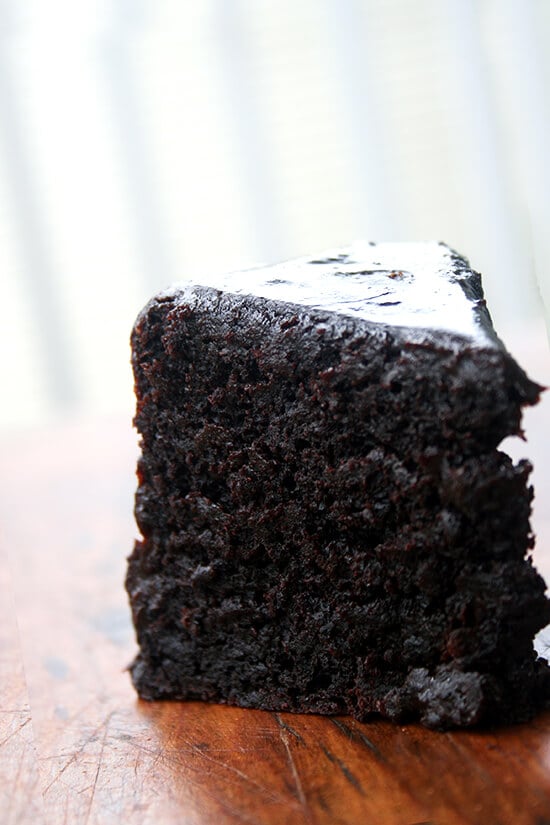
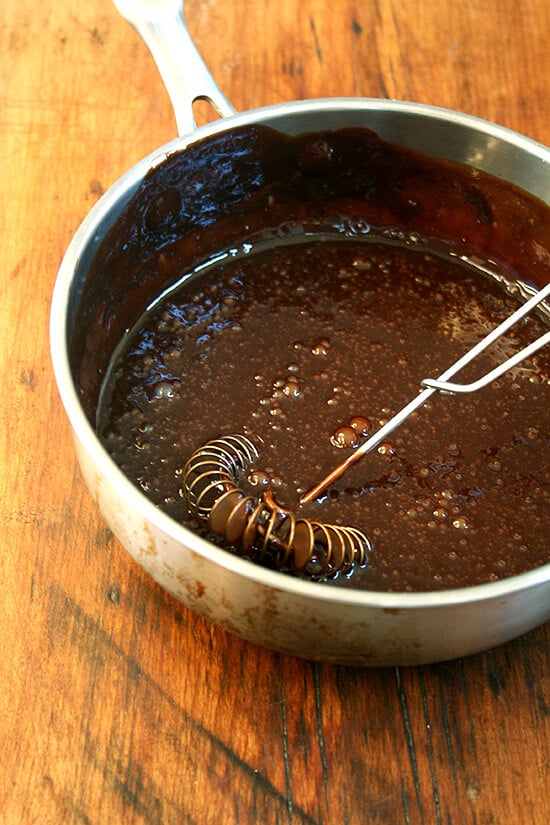
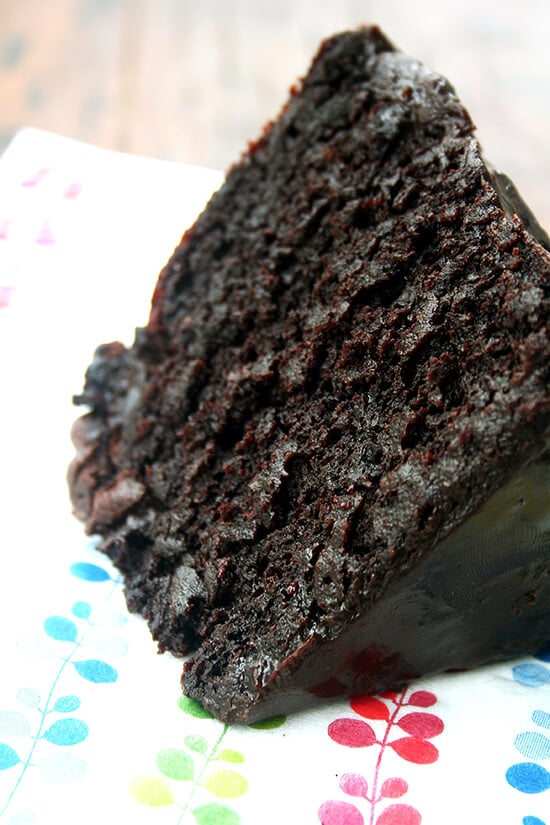
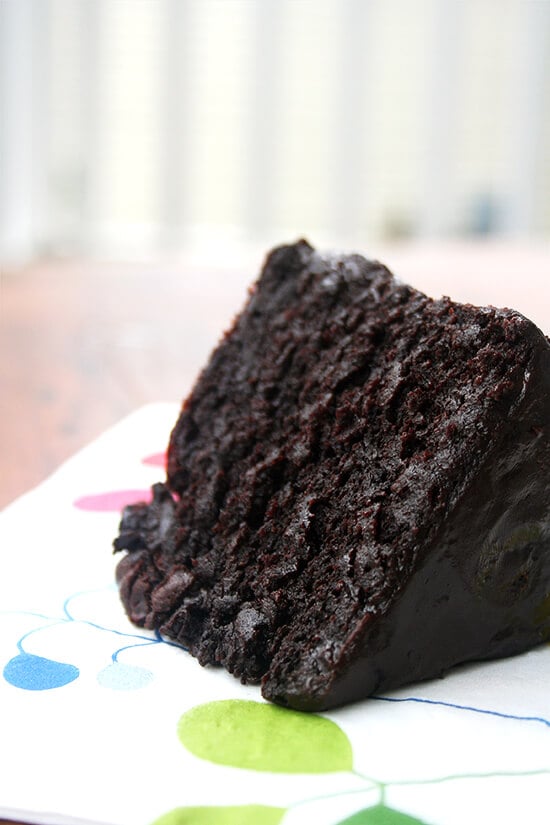
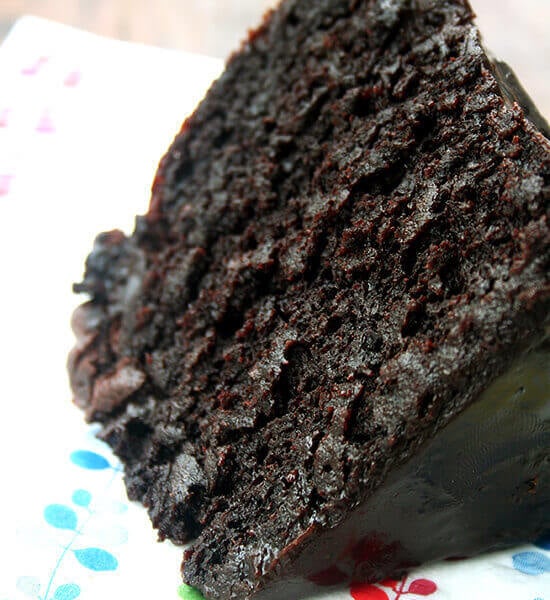
Double Chocolate Cake with Black Velvet Icing
- Total Time: 2 hours 10 minutes
- Yield: 10 to 12 servings
Description
Adapted from: Gourmet via Epicurious
Notes:
- The original recipe calls for making a chocolate ganache, which sounds heavenly, but I have always adored my grandmother’s chocolate glaze recipe — it’s called black velvet icing and it contains eggs, which is odd, but it’s so good — so that is the one I use. If you want to use Gourmet’s chocolate ganache, find it here.
- Some commenters have found the amount not to be enough for a full cake, so I’ve updated the quantities below to be a double batch, which should leave you with more than enough icing.
- If you want to make a half recipe, see this post: Gourmet’s Double Chocolate Cake, Revisited. I love these 6-inch cake pans for making half recipes of all sorts of cakes, namely this one. You need two.
Ingredients
for the cake:
- 3 ounces (85 g) fine-quality semisweet chocolate
- 1 1/2 cups hot brewed coffee
- 3 cups (648 g) sugar
- 2 1/2 cups (320 g) all-purpose flour
- 1 1/2 cups (144 g) unsweetened cocoa powder
- 2 teaspoons baking soda
- 3/4 teaspoon baking powder
- 1 1/4 teaspoons salt
- 3 large eggs
- 3/4 cup vegetable oil
- 1 1/2 cups well-shaken buttermilk
- 3/4 teaspoon vanilla
for the black velvet icing (*updated to a double recipe April 2020, see notes above):
- 8 oz semi-sweet chocolate
- a heaping 1/2 cup of confectioners’ sugar
- 6 eggs, well beaten
- 8 tablespoons butter, room temperature
Instructions
- Make the cake: Preheat oven to 300°F. and grease two 9- or 10-inch by 2-inch round cake pans with unsalted butter or nonstick spray. Line bottoms with rounds of parchment paper. Finely chop chocolate and in a bowl combine with hot coffee. Let mixture stand, stirring occasionally, until chocolate is melted and mixture is smooth.
- Into a large bowl sift together sugar, flour, cocoa powder, baking soda, baking powder, and salt. In another large bowl with an electric mixer, beat eggs until thickened slightly and lemon colored (about 3 minutes with a standing mixer or 5 minutes with a hand-held mixer). Slowly add oil, buttermilk, vanilla, and melted chocolate mixture to eggs, beating until combined well. Add sugar mixture and beat on medium speed until just combined. Divide batter between pans (being sure not to fill pans higher than 2/3 full—they will overflow if you do; it’s not worth it) and bake in the middle of oven until a tester inserted in center comes out clean, 1 hour to 1 hour and 10 minutes.
- Meanwhile, make the icing: Because several commenters have had trouble, with the icing, I am suggesting you use a double boiler. If you know how to set up a double boiler, do so; otherwise, fill a pot with an inch of water. Place a medium bowl over top. Turn the heat to medium. Place the chocolate in the bowl. Once it has melted, stir in the confectioners’ sugar, whisking until smooth. Stir in the eggs a little at a time, whisking vigorously after each addition — a flat-bottomed whisk is good for this. (I use a whisk until the ingredients are blended and then switch to a heat-proof spatula.) Cook over low to medium-low until thick. Stir in the butter one tablespoon at a time. Set aside to cool. Transfer to a glass measuring cup with a spout for easy pouring or store in whatever vessel you wish.
- Cool layers completely in pans on racks. Run a thin knife around edges of pans and invert layers onto racks. Remove parchment paper. Cake layers may be made 1 day ahead and kept, wrapped well in plastic wrap, at room temperature.
- If you are making a layer cake, halve each cake round crosswise to create 4 layers. Spread icing over one cake layer. Top layer with other cake layer. Repeat until all layers are stacked. Pour icing on top of top layer and with an off-set spatula (if you have one) spread it all over the sides. Cake keeps, covered and chilled, 3 days. Bring cake to room temperature before serving. (I keep mine at room temperature always…there’s never space in the fridge.)
- Prep Time: 30 minutes
- Cook Time: 60 minutes
- Category: Dessert
- Method: Oven
- Cuisine: American
This post may contain affiliate links. Please read my disclosure policy.

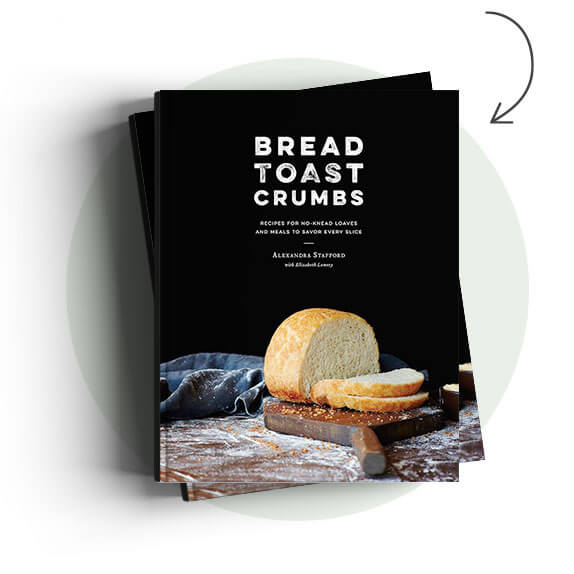

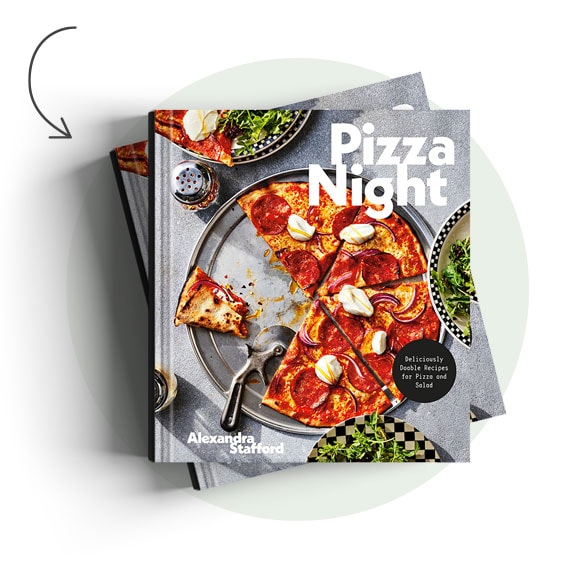
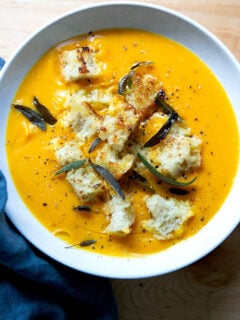
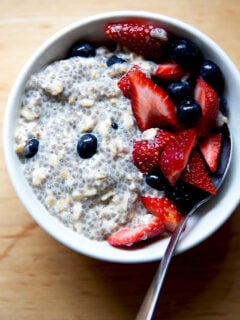
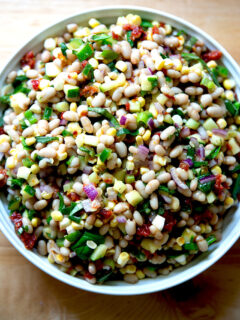
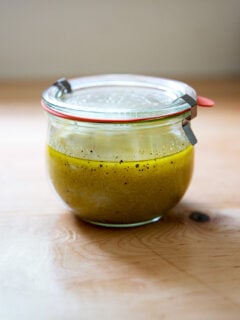
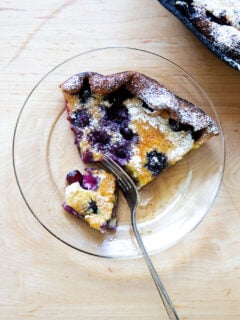
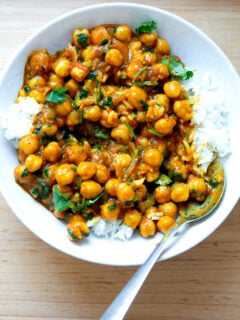

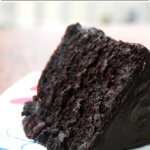
436 Comments on “The Best Double Chocolate Cake with Black Velvet Icing”
Just made this and the cake turned out AMAZING! It’s so good and moist! But from some reason when I made the icing the butter just wouldn’t mix. It sits on top leaving my icing lumpy and looking like a mess! Any ideas?
So happy to hear about the cake! It’s one of my favorites, too. OK, the icing, I have to admit, is a tricky/weird recipe, and it never feels right melting the chocolate over direct heat, but once you get the hang of it, it works well. The key is to just melt the chocolate slowly, and to add the eggs one at a time, mixing/stirring/cooking well after each addition, otherwise the mixture won’t thicken up.
hello. i love your chocolate cake BUT i couldnt make the icing right 🙁 🙁 it usually lump up on me when i start to mix in the eggs…. any tips to make this icing a success?
Jane, I’m so sorry to hear this! You are not the only one who has had trouble with this recipe. The key is to go really slowly over low heat, but I think I need to revisit this recipe because I hate thinking about people wasting ingredients. I will report back soon.
I had this problem as well. I tried again, with a double boiler. Melted the chocolate first. Then I tempered some of the melted chocolate with the well beaten eggs, then added it to the pot always using a whisk. PERFECTION! It almost didn’t make it onto the cake.
You are awesome!! Thanks so much for doing this. It has been on my to-do list for years … taking it off now :):) 🙂 🙂
I was going to suggest using a double boiler…glad to see it worked out.
My mothers Chocolate Cake has always been my favorite. Your recipe sounds good as well and I will give it a try.
I think the secret to the icing is to alternate adding the sugar and the eggs to the melted chocolate. Use a whisk, and just stir til your arm falls off. Then add the butter a Tbs. at a time, and stir til your arm falls off.
thaaaaank you for the tip!!! it was a success
happy! happy! happy!
Yay! And thank you Heather for helping out on this one!
I just made the cake today. I used two 8″ round pans and poured a little leftover batter into a square pan for “tasting”. It took about an hour and 10 min for 8″ pans on 300°.
I used Heather’s method for icing, which worked well.
Thanks for your input, Melissa. Hope the cake turned out well!
I tried making this cake and the cake itself is beautiful and delicious!! Didnt know it would make so much batter! but its so moist and perfect! Just what I was looking for. I just didnt like the taste of the icing 🙁 I made it perfectly, reading into the comments and finding out what I should do. But the taste wasnt so super 🙁 I havent iced the cake yet and I will try it out and hope its complementing to it :)Thanks Alexandra!
Huma, hi! And sorry for the delay here…I’ve been playing catch up ever since returning from WI a few weeks ago. Glad to hear the cake turned out well. Sorry to hear about the icing. How did it taste on the cake? What kind of chocolate did you use? I’m wondering if that had something to do with it.
My favorite use for unsweetened cocoa powder is using a tablespoon of it in a nut butter and instantly make chocolate nut butter,much healthier and less sugar (AND SO MUCH CHEAPER) than nutella. Yum!
Also tried the icing and came out lumpy, even after trying Heather’s suggestion. Oh well. Might try the ganache next time. Thanks for what looks like an amazing cake. (:
Loved this cake! I made the icing just as instructed and it turned out perfectly. Thanks!
This cake is so incredible, I made it last night and frosted it with some ganache and clementine zest. The citrus flavor really adds to it. Thank you for this wonderful recipe and detailed description!
I so want to make this cake can i use a bunt pan to make it in
Well, mine are in the oven, about half way thru… I’m confident they’ll taste good, however, I’ll need to clean my oven after this. I used 2 10×2 round cake pans like the recipe says. Maybe I beat my eggs longer than I was supposed to or something, but I was thinking it was a lot of batter for the pans.. I double and triple checked the recipe to be sure it was supposed to be in just 2 pans of that size, and thought, well maybe it doesn’t puff up that much? I almost didn’t fill them as high, but I thought I would just follow the recipe exactly. Turns out I did indeed have too much batter. Maybe add to the recipe to not fill pans more the 2/3 full? My cakes overflowed and are burning into the bottom of my oven. 🙁 hopefully I can trim up the cakes when they’re done, and hopefully they don’t taste like smoke. 🙁
Oh no! That is the worst. I’m sorry 🙁 I hate when batter burns on my oven floor. I don’t know what to say regarding the pans?! I suppose it is possible that the beaten eggs made the batter rise more, but this is odd. I will make a note in the recipe to not fill pans more than 3/4 full. How did the cake turn out?!
I had this as my birthday cake and it was delicious! I paired it with a chocolate buttercream frosting and would definitely make it again. It wasn’t too rich, but then again I love chocolate.
So happy to hear this, Emily! I haven’t made this in awhile, but it’s one of my favorites.
The original recipe say Unsweetened Cocoa; it will make a difference. This is like the Hershey’s Black Magic Cake and it call for unsweetened. If Baking Soda is more than Baking Powder, use unsweetened.
Help ! PLEASE advise, I can’t use coffee reg or decaf in anything, help me with a substitute for coffee in the black velvet icing???!!!
Just leave it out or use water. Good luck!
This looks heavenly! Will it work in 3 9″x1 1/2″ pans?
I think it will! THat’s actually probably ideal. Just be sure they’re only filled halfway or 2/3 full. Good luck!
How long should I bake it for in 3 9” pans?
How long to bake if I make cupcakes, instead?
This recipe sound delish.
I would say 15 to 20 minutes. Yum!
This cake is so delicious! The icing is amazing! There is a local restaurant WELL known for it’s chocolate cake. (President Obama has ordered their chocolate cake from them!) My husband swears this cake is better! Loved it!
SO awesome to hear this, Gina!! And thanks so much for your help with the icing … i’m so grateful!
Hi there!
I plan on making this for Sat. Can I bake the cake (birth layers) today, wrap it up real good with saran wrap and foil and freeze.? I plan to thaw it on Friday to frost it.
Correction…. I meant to say BOTH layers, not birth. Lol!
Auto correct, smart phone 😛
omg i love it. birth layers. so grateful for autocorrect. Yes! Definitely. I find these types of cakes freeze/thaw very well. Good luck!
This cake…looking at it makes me want to lick the screen haha. I do have some questions though. How many layers did you make and, does the batter freeze well in case you have some leftover but don’t want to immediately use it? I would love to make this for my birthday this Friday even though my mom thinks it’s weird that I want to make my own cake.
Haha, I love it — I don’t think it’s weird at all. I’ve definitely done that. I don’t know that freezing cake batter is a great idea. I would suggest making cupcakes with any remaining batter, then freezing those cupcakes.
I typically bake two layers, then I cut each of those layers in half to create 4 total. Hope that helps. Happy Birthday!
Came across this recipe, (years later clearly)and want to try it, but I’m confused. All info and descriptions have great info on natural cocoa etc, but then the recipe i’m seeing calls for 3 oz of SEMI SWEET chocolate! Did it get changed sometime? Which do you recommend? Thanks! Kathy
Hi Kathy! The original recipe does indeed call for semi sweet chocolate; you can find that recipe on Epicurious.
There is 1.5 cups cocoa powder, too — did you see that?
Let me know if this has clarified things!
Hi! I want to make this for my boyfriend’s birthday but he’s not a coffee fan. Does the cake actually have a coffee flavor? Thanks!
No coffee flavor! Coffee, apparently, enhances the chocolate flavor, but the taste in the end is unnoticeable.
Hi there
I made this cake for my 1st & 3rd daughters’ birthdays. They celebrated together.
It turned out GREAT & my children loved it. The people who ate it gave their thumbs up too.
I lessened the cocoa powder abt maybe 10 or 20 grams and added double the amount of the choc drops & it still turned out
I didn’t need any icing. It tastes soooo good on its own.
However I later made some ganache and it enhanced the great taste of the cake even more.
Yes…i think it is the best choc cake recipe ever.
Thank you sharing this wonderful recipe with us.
4.8 stars!
So happy to hear all of this Shafi’ah! I love that your daughters can celebrate their birthdays together … so sweet. Glad to hear icing is unnecessary! I have been meaning to revisit this cake and when I do, I am going to try the ganache — others have suggested the same. Yum! Thanks so much for writing in. Happy Birthday to your sweet girls.
Thank you Alenxandra.
Yup..please do try the ganache. I just love ganache-s. Hehe!
This recipe is for keeps!
Yay! Will do, thanks!
Something missing from my comment earlier.
Supposed to be…& it still turned out amazing.
Got it, perfect, thanks 🙂
Before I made this I read the comments. LOL. #1)Made as directed, you have a 3-4 layer cake. Super impressive. If you don’t whip the eggs as long as instructed (5 minutes), you’ll have a less volumous batter=denser/moister cake. 2)”Lumps in icing” will happen if you over heat the chocolate before you mix in the raw eggs. Why? Because you scrambled the egg in the hot chocolate. Chocolate melts at a very low temperature, so over heating is totally unnecessary. STAY at the stove and whisk that icing until it’s thick. Beacause I had so many layers, I added 1/3 coconut oil and 1/4 cup cocoa power to thin it out. It was still thick, it spread easy, and I had enough for All Those Layers! 3)Good throw-ins would be dried cherries, cinnamon, cardamom, and coffee powder if your coffee isn’t super strong (and I like swapping vanilla for almond extract personally.) Coconut flakes/chocolate curls sprinkled on top added sophistication. 4)The icing is pretty brilliant, but it tastes like smooth fudge…not like a chocolate ganash…just FYI. If you want thick layers of icing you need to double the recipie and don’t thin it with coconut oil until you are done frosting between the layers. I used convection oven and got it out in 45-50 minutes. Hope this helps.
Thanks so much for all of this — super helpful and thorough. Much appreciated!
This looks marvelous. What do you use for vegetable oil in this recipe ?
I typically buy grapeseed oil or organic canola oil, but plain oil vegetable oil works fine, too.
How did you halve the recipe when there’s 3 eggs required?
Hiii
I hope to make this cake for my Boyfriends birthday Nov22nd and I want to make it a Carved cake of a Roasted Turkey.
Is this cake dourable (err will it not crumble) for carving?
If I bake 2 layers and cut them in half to make 4 layers, do I need to double the frosting recipe?
Hi, I have been searching for a very dark and moist chocolate cake and this looks like “the one”! I wonder if anyone has baked it in a Bundt pan?
I have not, but I love my bundt pan …cakes always turn out so well in it. Go for it!